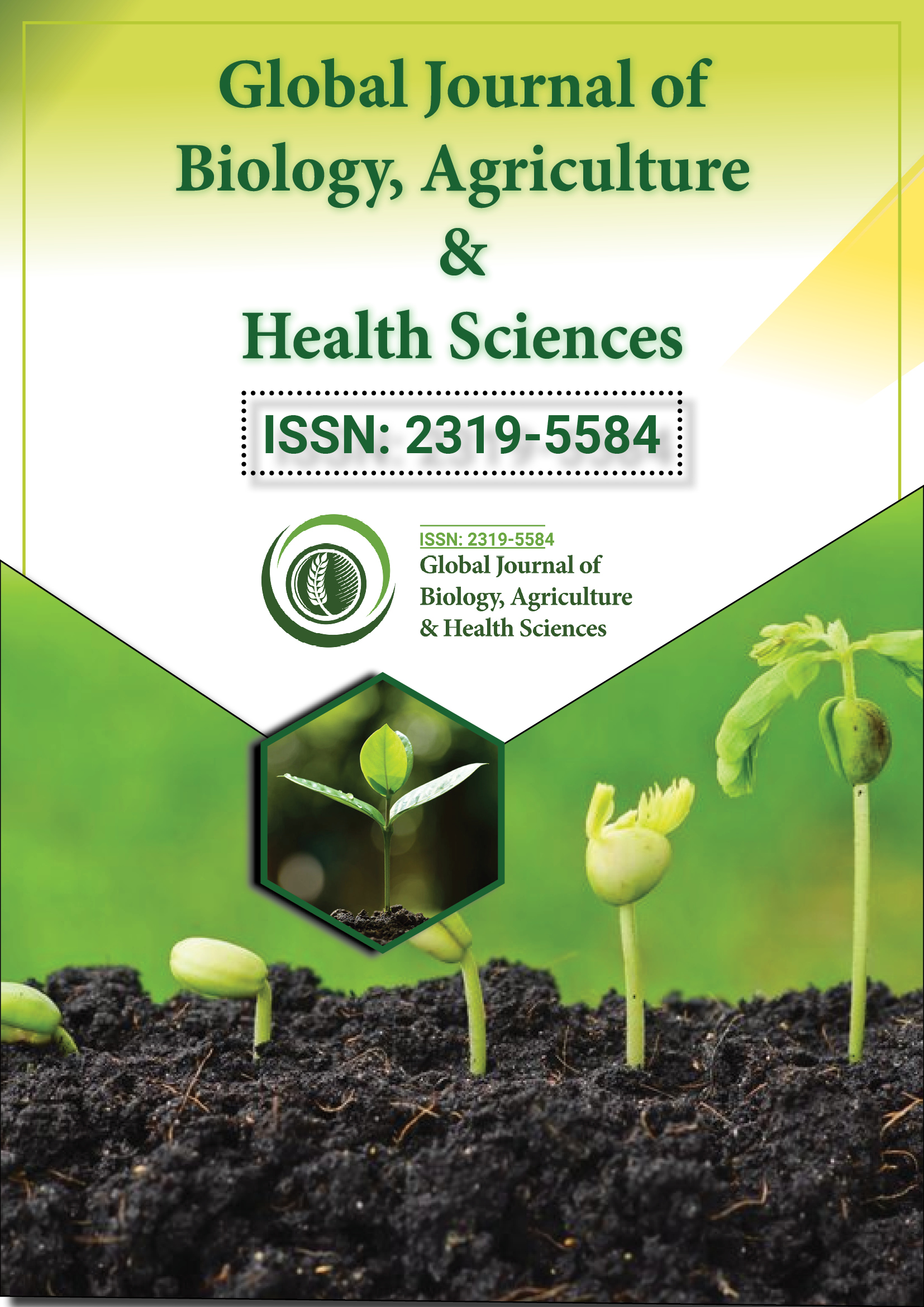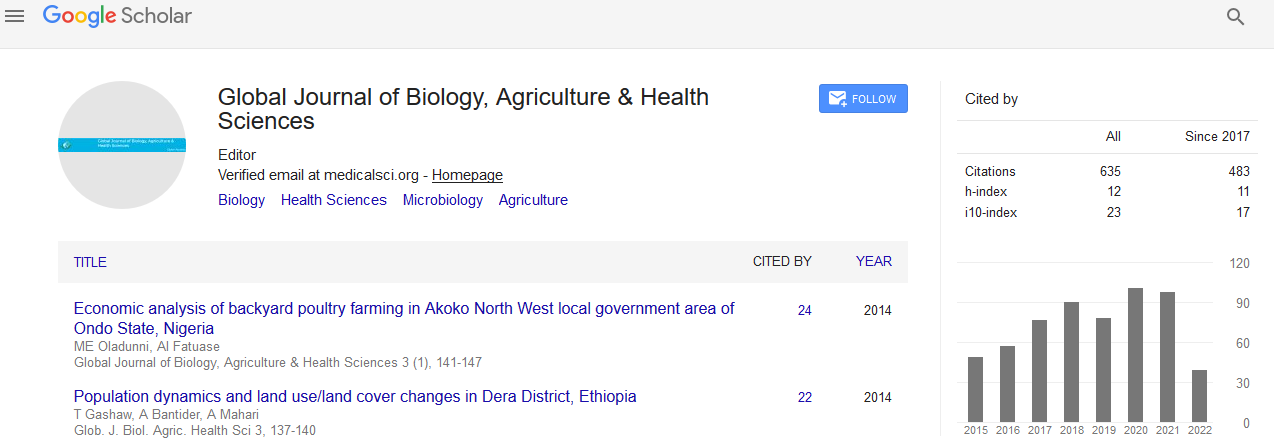Indexed In
- Euro Pub
- Google Scholar
Useful Links
Share This Page
Journal Flyer

Open Access Journals
- Agri and Aquaculture
- Biochemistry
- Bioinformatics & Systems Biology
- Business & Management
- Chemistry
- Clinical Sciences
- Engineering
- Food & Nutrition
- General Science
- Genetics & Molecular Biology
- Immunology & Microbiology
- Medical Sciences
- Neuroscience & Psychology
- Nursing & Health Care
- Pharmaceutical Sciences
Short Communication - (2024) Volume 13, Issue 4
Improving Learning Outcomes in Microbiology with the Concept Inventory
Czopik Atkins*Received: 27-Nov-2024, Manuscript No. GJHABS-24-28156; Editor assigned: 29-Nov-2024, Pre QC No. GJHABS-24-28156 (PQ); Reviewed: 13-Dec-2024, QC No. GJHABS-24-28156; Revised: 20-Dec-2024, Manuscript No. GJHABS-24-28156 (R); Published: 27-Dec-2024, DOI: 10.35248/2319-5584.24.13.237
Description
Microbiology, the study of microorganisms and their interactions with humans, animals and the environment, is an essential field of science that impacts health, agriculture and various industrial sectors. The Microbiology Concept Inventory (MCI) is an assessment tool developed to measure students' understanding of fundamental microbiological concepts. The application of the MCI has transformed the way educators assess and improve learning outcomes in microbiology education, contributing significantly to the development of effective teaching strategies. This article discusses the importance of the MCI in microbiology education, how it works and its benefits in improving both student comprehension and curriculum development.
The Microbiology Concept Inventory is a set of multiple-choice questions designed to evaluate the core principles of microbiology. It serves as a diagnostic tool, helping instructors identify areas of strength and weakness in students’ knowledge. The MCI assesses the understanding of key topics, such as the diversity of microbial life, microbial metabolism, genetics and the immune system. By focusing on fundamental principles, the MCI aims to distinguish between students’ ability to recall facts and their capacity to apply those facts in real-world scenarios [1-4].
Unlike traditional assessments that measure rote memorization, the MCI is designed to evaluate conceptual understanding. It targets the underlying cognitive processes that students use to solve problems and make connections across different microbiological topics. As such, it is not only a tool for educators to gauge learning progress but also a resource for enhancing teaching methods by providing insight into students’ misconceptions and gaps in knowledge [5-8].
Microbiology is a subject that can be challenging for students due to the complexity of the concepts involved and the abstract nature of microorganisms. Traditional methods of teaching often emphasize the delivery of content through lectures and textbooks, but such methods may not always promote deep understanding. The application of the MCI offers a structured way to identify whether students truly grasp the material or are merely memorizing information.
One of the main benefits of using the MCI is that it provides instructors with immediate feedback about how well students understand critical concepts. This feedback can be used to adjust teaching strategies, reinforce key concepts and address common misconceptions. By aligning assessments with the cognitive skills that are central to understanding microbiology, the MCI supports more effective teaching and learning processes.
Furthermore, the MCI contributes to the evolution of curriculum development. The inventory is designed to identify both the strengths and weaknesses in the current educational approach, giving faculty valuable data to refine their teaching materials and course objectives. It encourages educators to prioritize conceptual clarity and to integrate interactive learning activities that promote problem-solving and critical thinking.
Incorporating the MCI into microbiology courses can be transformative for both students and instructors. Several strategies can be employed to utilize the MCI effectively in educational settings. One of the most significant applications is its use in formative assessments, where it helps instructors monitor student progress throughout the course. Instead of relying solely on midterm or final exams, the MCI allows for continuous assessment, which can guide instructional decisions on a more timely basis.
The MCI can also be used in pre- and post-assessment formats. Administering the inventory before and after a unit of instruction allows instructors to measure how much students have learned and whether teaching methods are achieving the desired outcomes. This before-and-after comparison helps gauge the effectiveness of specific teaching interventions and the retention of knowledge over time.
Another application of the MCI is in peer instruction, where students can engage with each other in discussion and review of the correct answers. This collaborative learning environment encourages students to think critically and clarify their understanding of microbiological concepts. Peer instruction enhances problem-solving skills and provides students with opportunities to learn from their peers, making the learning experience more interactive and participatory [9,10].
Conclusion
Additionally, the MCI can be adapted for use in laboratory courses. Many microbiology programs incorporate practical lab sessions where students apply theoretical knowledge to realworld experiments. The MCI can help assess whether students are connecting their lab experiences to the broader concepts they are studying. This integration of theory and practice is essential for preparing students for professional careers in the field of microbiology.
A major advantage of using the MCI is its ability to uncover misconceptions and gaps in students' understanding. Misconceptions are common in microbiology, especially when students attempt to reconcile complex and often contradictory ideas. For instance, students might struggle with understanding the differences between prokaryotic and eukaryotic cells, or they may misunderstand the role of microorganisms in disease processes.
By analyzing the responses to the MCI, instructors can pinpoint specific areas where students are struggling and offer targeted interventions. This can involve revisiting certain topics, offering additional resources, or adjusting teaching methods to clarify misunderstood concepts. The ability to address these misconceptions early in the learning process helps ensure that students build a solid foundation in microbiology, which is critical for success in advanced coursework or professional practice.
References
- Anand A, Arkin A, Dukes F, Mageeney C, Mukundan H, Mutalik V. Bridging the gap: Pathway programs for inclusion and persistence in microbiology. Trends Microbiol. 2025.
[Crossref] [Google Scholar] [PubMed]
- Akob DM, Oates AE, Girguis PR, Badgley BD, Cooper VS, Poretsky RS, et al. Perspectives on the future of ecology, evolution, and biodiversity from the council on microbial sciences of the American society for microbiology. Msphere. 2024;9(11):e00307 -324.
[Crossref] [Google Scholar] [PubMed]
- Polo JM, Sanchez JL, Arca-Suarez J, Estella A, Gonzalez P, Blasco M, et al. The importance of antimicrobial strategies associated with clinical cure and increased microbiological eradication in patients with complicated urinary tract infections and high risk of relapse. European Urology Open Science. 2025;71:165-171.
[Crossref] [Google Scholar] [PubMed]
- Mariana C, Olivier P, Christian TL, Patricia MG, Francesco AT, Antonio GP, et al. Current microbiological testing approaches and documented infections at febrile neutropenia onset in patients with hematologic malignancies. Int J Infect Dis. 2024;147:107183.
[Crossref] [Google Scholar] [PubMed]
- Akinsemolu A, Onyeaka H. Application of green microbiology for microplastic remediation: Current progress and future perspectives. Environ Adv. 2024, 100569.
- Olbrich L, Franckling-Smith Z, Larsson L, Sabi I, Ntinginya NE, Khosa C, et al. Sequential and parallel testing for microbiological confirmation of tuberculosis disease in children in five low-income and middle-income countries: A secondary analysis of the RaPaed-TB study. Lancet Infect Dis. 2024.
[Crossref] [Google Scholar] [PubMed]
- Fernandes AB, Pereira CF, Pereira HM, Batista MA, Dionisio LF, Alfieri AA, et al. Validation of immersion pre-cooling and drip sanitation standard operating procedures on weight, temperature, microbiological quality, and safety of chicken carcasses. J Food Prot. 2025;100451.
[Crossref] [Google Scholar] [PubMed]
- Teotia AK, Chauhan AS, Thota P, Kumari B, Verma O, Phathak C, et al. Engineering advances in safe laboratory design for pharmaceutical microbiology and assessment of their biohazard risk measures. Saf Sci. 2024;174:106458.
- Culbreath K, Hemarajata P, Thomson Jr RB, Yee R. A day in the life of a medical microbiology director: Navigating the diverse duties as a clinical conductor. Clin Microbiol Newsl. 2024.
- Fujihara T, Matsuo H, Yamamoto G, Sunada A, Hamaguchi S, Onozuka D, et al. Accuracy of odor-based microorganism identification by microbiological technologists with different years of experience: A cross-sectional study. Heliyon. 2024;10(16).
[Crossref] [Google Scholar] [PubMed]
Citation: Atkins C (2024). Improving Learning Outcomes in Microbiology with the Concept Inventory. Glob J Agric Health Sci.13.237.
Copyright: © 2024 Atkins C. This is an open-access article distributed under the terms of the Creative Commons Attribution License, which permits unrestricted use, distribution, and reproduction in any medium, provided the original author and source are credited.

